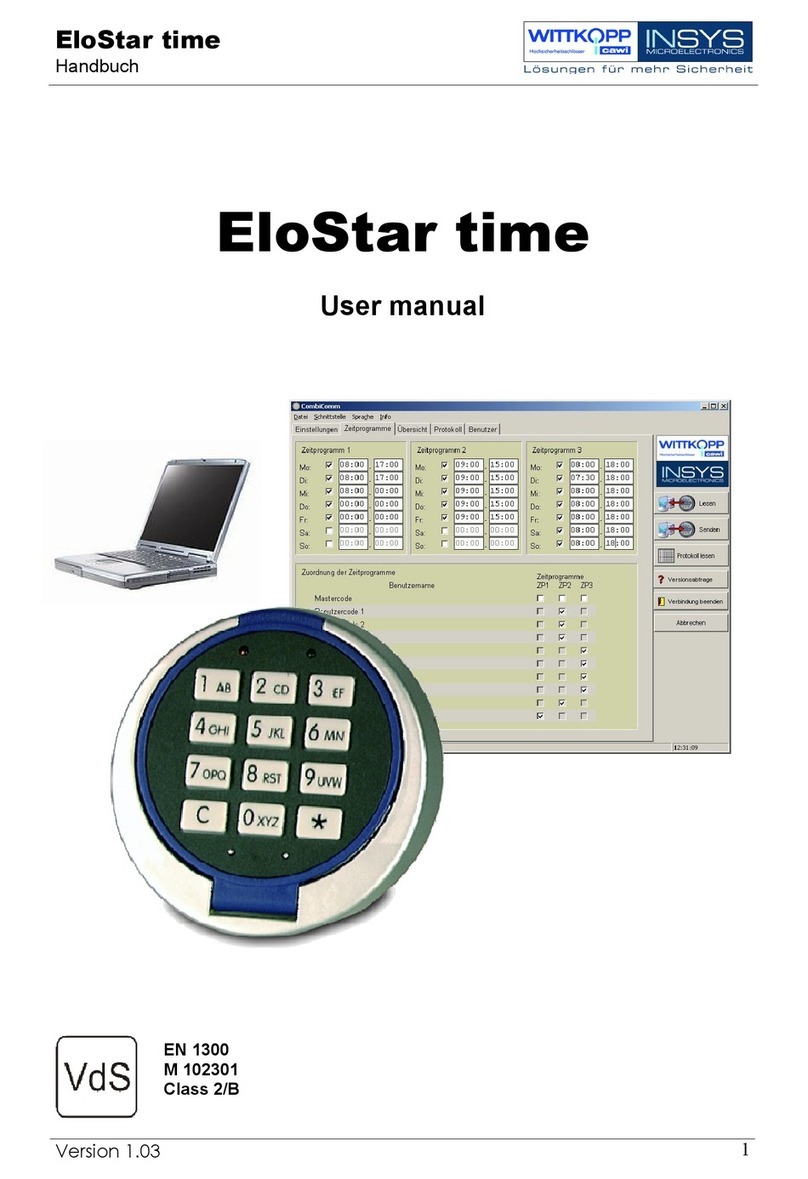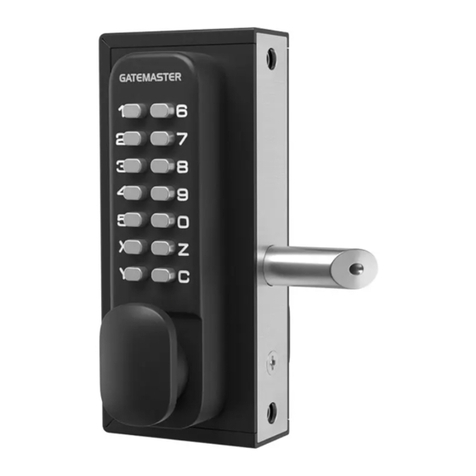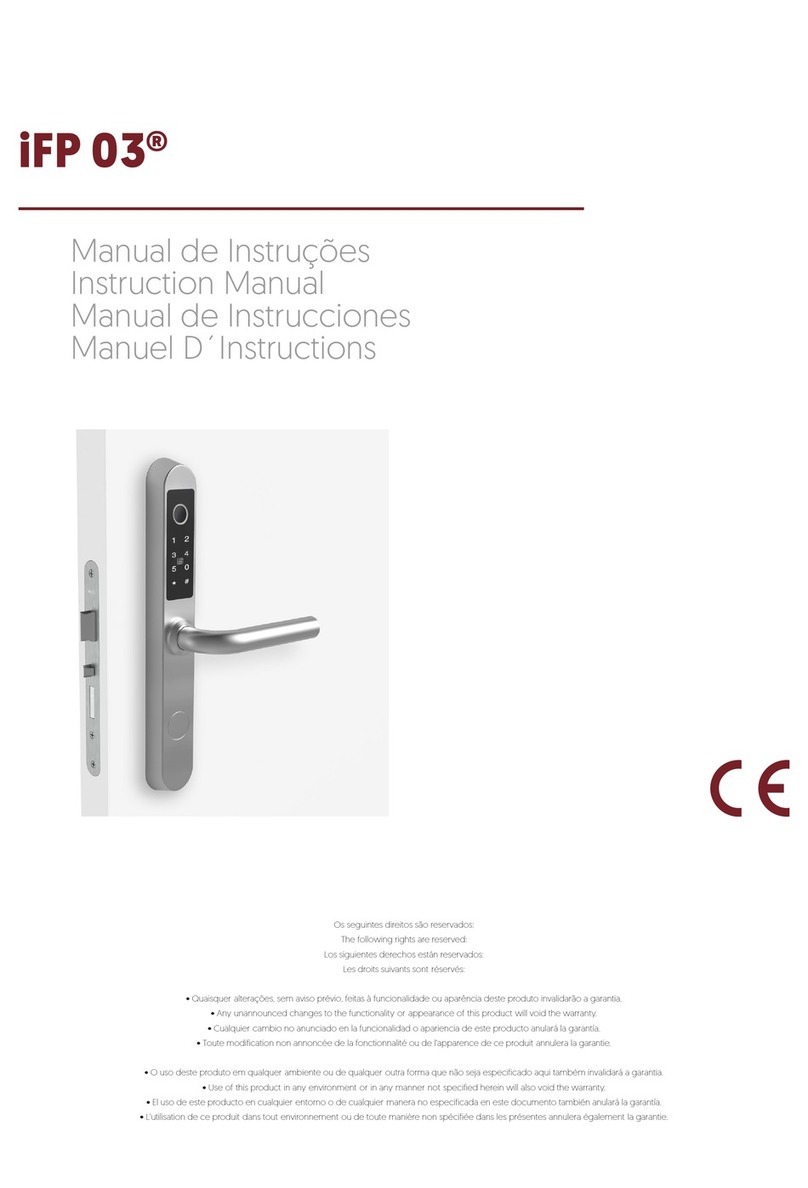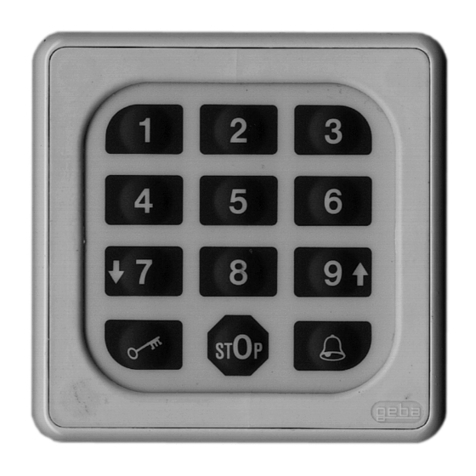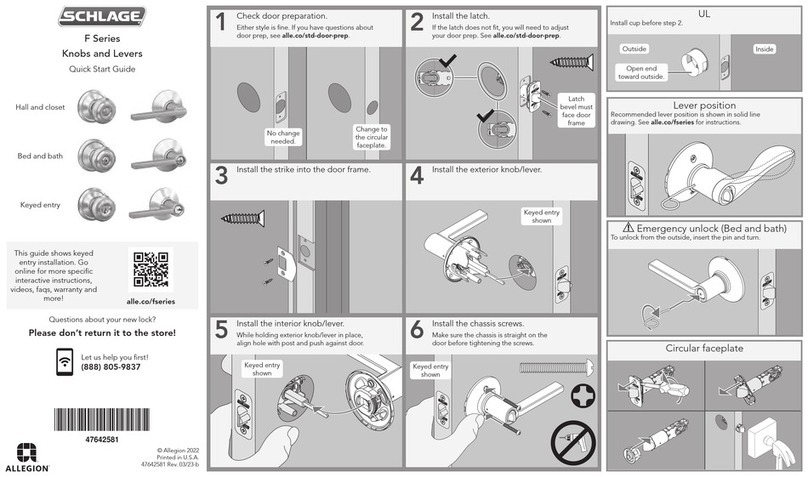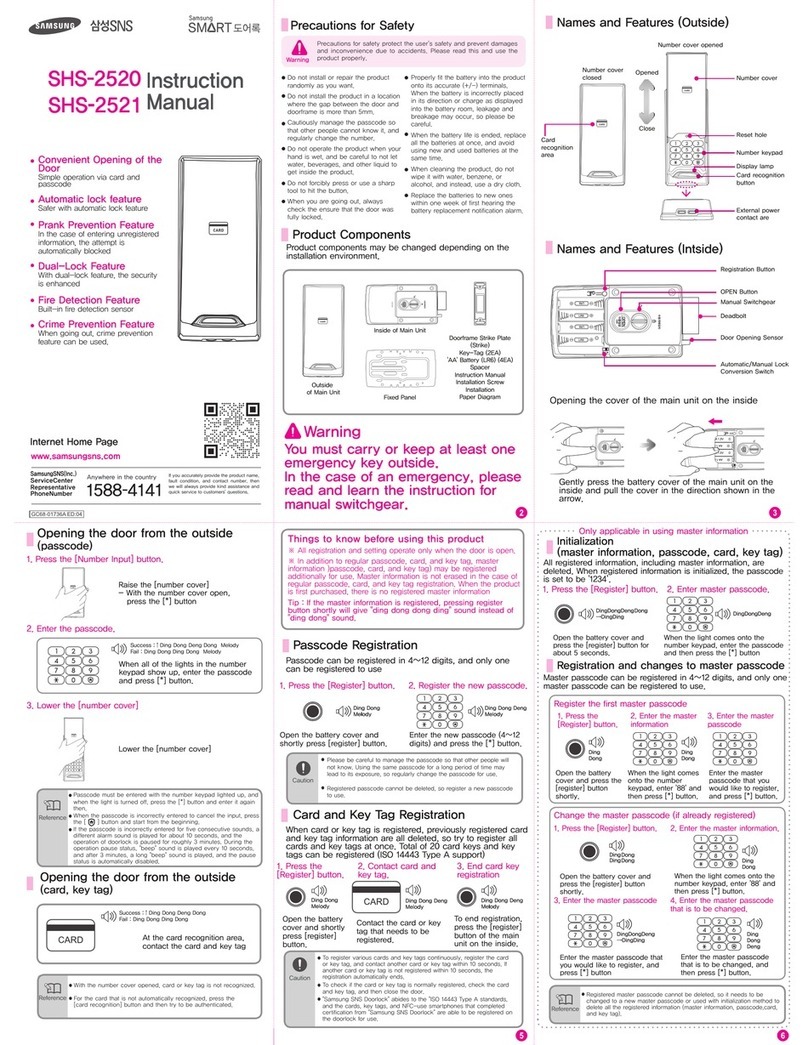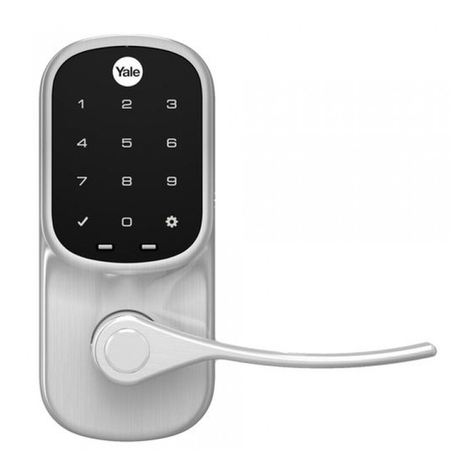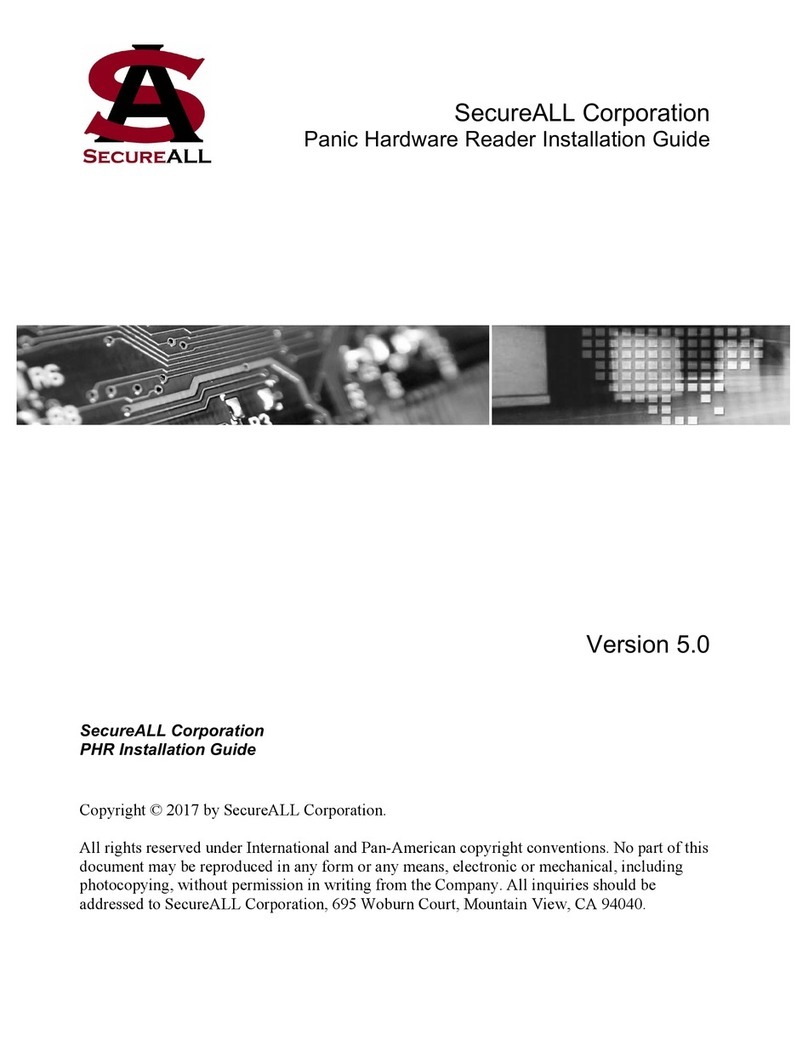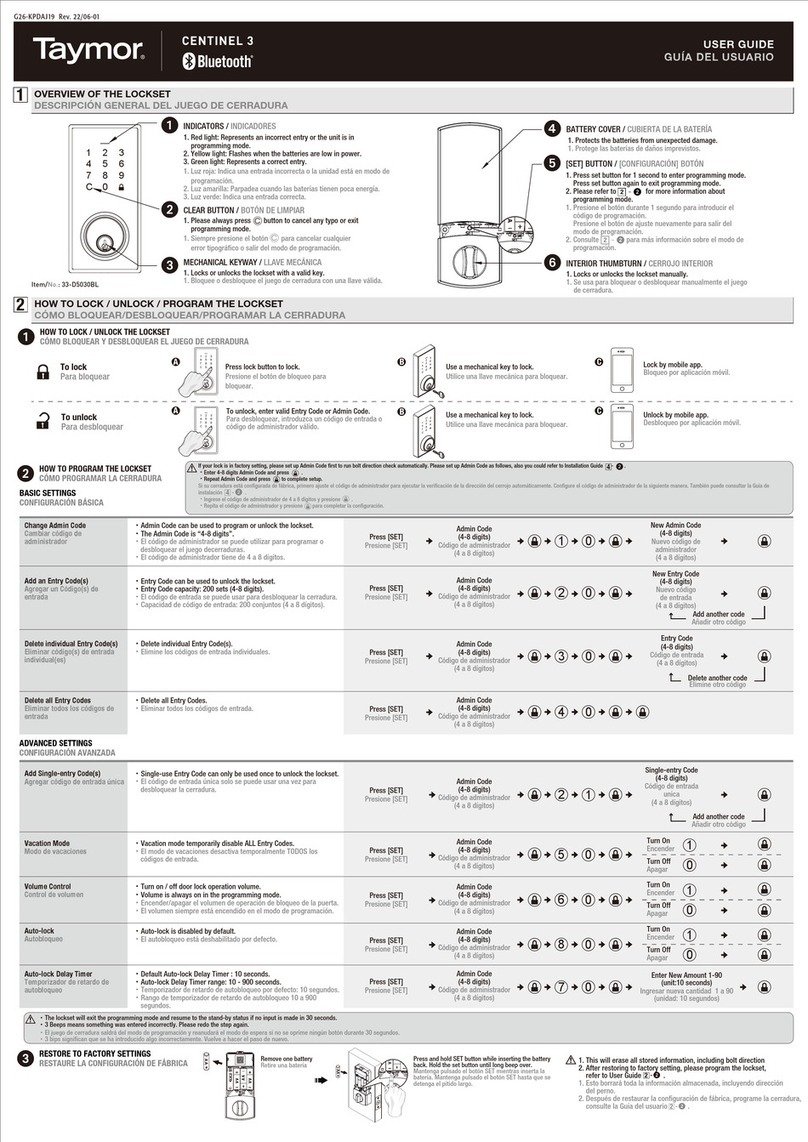INSYS TwinLock compact User manual

TwinLock compact
Manual
Version 1.06
1
TwinLock compact
Manual
EN 1300
M 106302 / M 106301
G 106016 / G 106015
Class 2 / C

TwinLock compact
Manual
Version 1.06
2
Copyright © Septe ber 08 INSYS MICROELECTRONICS G bH
Any duplication of this anual is prohibited. All rights on this docu entation and the devices are with
INSYS MICROELECTRONICS G bH Regensburg.
Restrictions of guarantee
This handbook contains a concise description. The co pilation of the text has been ade with the
ut ost care. Despite all efforts, there ay be deviations to the actual functions. No guarantee can
therefore be given for the accuracy of the contents. We can neither assu e legal responsibility nor
any liability for incorrect infor ation and their consequences. Suggestions for i prove ents and
co ents are always welco e.
Trade arks and logos
The use of a trade ark or logo not shown below does not indicate that it is freely available for use.
INSYS ® is a registered trade ark of INSYS MICROELECTRONICS G bH.
Windows™ is a registered trade ark of Microsoft Corporation.
Publisher:
INSYS MICROELECTRONICS G bH Carl Wittkopp G bH & Co. KG
Waffnergasse 8 Sternbergstr. 5
93047 Regensburg, Ger any 42551 Velbert, Ger any
Phone: +49 (0) 941/58692-22 Phone: +49 (0) 2051/9566-0
Fax: +49 (0) 941/563471 Fax: +49 (0) 2051/9566-66
Internet: http://www.insys-security.de Internet: http://www.cawi.co
Subject to technical changes. Errors excepted.
Date: Septe ber 08
Version: 1.06

TwinLock compact
Manual
Version 1.06
3
The anual contains detailed infor ation for the operation and the progra ing of
the high-safety lock TwinLock compact and is ainly intended for the syste
MASTER responsible for the syste configuration and ad inistration.
For users, we reco end the Quick Reference Guide. The concise docu ent
contains all i portant infor ation required for nor al syste operation in short for .
The docu ent ASSEMBLY INSTRUCTIONS has been created to assist with the
installation of the syste . This contains all infor ation for the i ple entation of the
TwinLock syste .

TwinLock compact
Manual
Version 1.06
4
Table of contents
1. SYSTEM DIAGRAM ....................................................................................................................................... 6
2. SYSTEM DESCRIPTION................................................................................................................................ 7
2.1.
I
NPUT
U
NIT
:
F
LAT
C
ONTROL
......................................................................................................................... 7
2.2.
L
OCK
:
T
WIN
L
OCK COMPACT
........................................................................................................................ 7
2.3.
B
US
D
ISTRIBUTOR
:
T
WIN
C
ONNECT
.............................................................................................................. 7
2.4.
E
XTENSION
U
NIT
:
T
WIN
XT.......................................................................................................................... 8
2.5.
C
HIP
C
ARDS
(T
WIN
C
ARD
............................................................................................................................ 9
2.6.
C
ONFIGURATION
S
ET
T
WIN
C
OMM
.............................................................................................................. 10
3. FUNCTION DESCRIPTION......................................................................................................................... 11
3.1.
C
ODE AND
L
OCKING
F
UNCTIONS
................................................................................................................ 12
3.2.
T
IMER
F
UNCTIONS
...................................................................................................................................... 15
3.3.
S
ERVICE
F
UNCTIONS
................................................................................................................................... 16
3.4.
O
PERATIONAL
S
AFETY
................................................................................................................................ 17
3.5.
S
ABOTAGE SAFETY
...................................................................................................................................... 19
3.6.
PC
S
UPPORT WITH
C
ONFIGURATION
S
ET
T
WIN
C
OMM
................................................................................ 19
4. OPERATION .................................................................................................................................................. 20
4.1.
D
ISPLAY AND
C
ONTROL
E
LEMENTS OF THE
I
NPUT
E
QUIPMENT
.................................................................. 20
4.3.
G
ENERAL
O
PERATING
I
NSTRUCTIONS
......................................................................................................... 22
5. GENERAL OPERATION PROCESSES...................................................................................................... 24
5.1.
U
NLOCKING A
L
OCK
................................................................................................................................... 24
5.2.
C
LOSING A
L
OCK
........................................................................................................................................ 25
5.3.
S
TATUS
R
EQUEST OF A
L
OCK
/
VERSION REQUEST
....................................................................................... 26
5.4.
R
ESPONSES
.................................................................................................................................................. 27
6. PROGRAMMING THE SYSTEM WITH THE CONTROL UNIT .......................................................... 29
6.1.
R
EPROGRAMMING A
M
ASTER
C
ODE
............................................................................................................ 30
6.2.
R
EPROGRAMMING THE
M
ANAGER
C
ODE
.................................................................................................... 31
6.3.
P
ROGRAMMING AND
R
EPROGRAMMING OF A
U
SER
C
ODE
........................................................................... 32
6.4.
D
ELETE A USER CODE
.................................................................................................................................. 33
6.5.
D
ISPLAY THE
P
ROGRAMMED
U
SER
C
ODES
.................................................................................................. 34
6.6.
S
ETTING THE
D
ATE
,
T
IME AND
W
EEKDAY
.................................................................................................. 35
6.7.
C
ODE
L
INKAGE
P
ROGRAMMING
(F
OUR
-E
YE
-C
ODE
................................................................................... 36
6.8.
P
ROGRAM
U
NLOCKING
T
IME
D
ELAY
.......................................................................................................... 37
6.9.
P
ROGRAM
O
PENING
D
URESS
(F
ORCED
S
EQUENCE
..................................................................................... 38
6.10.
P
ROGRAM SILENT ALARM
.......................................................................................................................... 39
6.11.
P
ROGRAMMING ACTIVATION OF
T
WIN
XT
LOCK
I/O.................................................................................. 40
6.12.
R
ESET THE
I
NPUT
U
NIT
............................................................................................................................. 41
6.13.
L
OCK
M
OTOR
S
ERVICE
............................................................................................................................. 43
6.14.
R
EGISTER
/R
EPLACE
L
OCKS IN THE
S
YSTEM
.............................................................................................. 44
6.15.
W
RITE
L
OG AND
C
ONFIGURATION TO
C
HIP
C
ARD
.................................................................................... 45
6.16.
W
RITE
L
OG AND
C
ONFIGURATION TO
C
HIP
C
ARD
.................................................................................... 46
6.17.
R
EAD
N
EW
S
YSTEM
L
ANGUAGE
............................................................................................................... 47
6.18.
I
GNORE
B
OLT
S
YSTEM
P
OSITION
S
WITCH
................................................................................................. 48
6.19.
A
CTIVATE
P
ARALLEL
C
ODE
...................................................................................................................... 49
6.20.
A
UTOMATIC
L
OCKING
............................................................................................................................... 50
7. PROGRAMMING THE SYSTEM WITH THE PC SOFTWARE TWINCOMM................................... 51
7.1.
G
ENERAL
O
PERATION
................................................................................................................................. 52
7.2.
P
ROGRAMMING OF
G
ENERAL
S
ETTINGS
...................................................................................................... 54
7.3.
P
ROGRAMMING THE
U
NLOCKING
D
ELAY
.................................................................................................... 57

TwinLock compact
Manual
Version 1.06
5
7.4.
D
ISPLAY
E
VENT
L
OG
.................................................................................................................................. 58
7.5.
U
SER
D
ATA
M
ANAGEMENT
........................................................................................................................ 59
7.6.
C
USTOMER
D
ATA
M
ANAGEMENT
............................................................................................................... 60
8. TECHNICAL DATA ...................................................................................................................................... 61
Revision History
Support / Hotline

TwinLock compact
Manual
Version 1.06
6
1. System Diagram
TwinLock compact – 1 lock with 12 DC power supply / TwinXT optional
TwinLock compact – 2 locks with 12 DC power supply / TwinXT optional
1 2 3
4
7
F
5 6
8 9
0 F
TwinConnect
TwinLock
TwinXT
1 2 3
4
7
F
5 6
8 9
0 F
TwinConnect
TwinLock
TwinXT
TwinLock

TwinLock compact
Manual
Version 1.06
7
2. System Description
TwinLock compact is an electronic high safety lock syste with integrated ar ing
device for a burglary alar syste class 3/C. It is a odular syste .
The security-relevant syste parts are designed fully redundant.
The syste consists of the following co ponents:
1-2 Control units = Ter inals
1-2 locks
1 Bus distributor = Connector for the individual co ponents (hub)
1 Extension units TwinXT
2.1. Input Unit : FlatControl
The input unit is ounted on the outside of the safe (see
asse bly of the input unit) and is used to control and
operate the locking syste (code input, progra ing,
etc.), as well as to ar or disar a burglary alar
syste using a physical code (chip card).
2.2. Lock : TwinLock compact
The locks are ounted within the secured area of the
safe (see asse bly of locks). The ne onic codes are
stored and evaluated inside the locks.
2.3. Bus Distributor : TwinConnect
The bus distributor TwinConnect enables the connection
of the individual syste co ponents.
In addition, TwinConnect has a power supply unit (12
VDC), which can supply the TwinLock co pact
syste . (When the ar ing device is connected,
however, the syste ust be supplied through the
BAS).

TwinLock compact
Manual
Version 1.06
8
2.4. xtension Unit : TwinXT
The TwinLock co pact syste can be extended by 2
inputs and 2 outputs by eans of the extension unit
TwinXT very easily. Basically, a TwinXT can be
connected to each lock in the syste . Consequently,
each lock can be specifically locked or released, and
each lock can have a bolt syste contact.
2 switching inputs (release/bolt syste contact) for lock 1
2 switching inputs (release/bolt syste contact) for lock 2
2 relay outputs (status/silent alar ) (30V/1A)
Power supply 12 VDC
Antita per loop with ta per switch

TwinLock compact
Manual
Version 1.06
9
2.5. Chip Cards (TwinCard)
TwinCard code access
Chip card as ‘physical code’ to disar
a BAS.
The code is changed continuously.
TwinCard configuration
Chip card for the syste configuration
and the event log. In cooperation the
with PC software TwinCo , the
configuration can be i ported or
exported and the log can be read out.
TwinCard language
Chip card for the configuration of the
syste language. (Ger an, English,
Czech, Portuguese…)
TwinCard TwinComm
Lizenzchipkarte for the TwinCo
configuration Software.

TwinLock compact
Manual
Version 1.06
10
2.6. Configuration Set TwinComm
The TwinLock co pact syste can be configured fast and conveniently using the
progra TwinCo in connection with the chip card reader of the configuration set
and the chip card TwinCard configuration. All settings and the event log can be
displayed, printed and saved.
Daten-I port
Konfiguration
TwinLock
TwinCard
-
Configuration
-

TwinLock compact
Manual
Version 1.06
11
3. Function Description
Code and Locking Functions
1 Master code per lock
1 Syste code
99 User codes per lock
Status indicator for progra ed user codes
Code linking (Four-eye code )
Silent alar
Code anipulation detection
Quick unlocking code
Opening duress (forced sequence)
Parallel code
Auto atic lock with door switch
Timer Functions
Ti e delay
Alar /sabotage delays
Auto atic switching to daylight savings ti e
Service Functions
Event log 768 events
I port/export of the configuration via chip card
Syste language can be configured using the chip card
Reset of the individual syste co ponents
Query of the syste co ponent version
Syste co ponents login/logout
Step-by-step operation for otor test
Syste line free configurable
Syste status indicator
Voltage onitoring

TwinLock compact
Manual
Version 1.06
12
3.1. Code and Locking Functions
Master code
Each lock has a aster code (ID = 00 + 6-digit aster code).
The aster code has the authorization to progra lock-specific procedures (e.g. ti e
delay, user codes, etc.) or to unlock, respectively.
The aster code can not be deleted or deactivated.
Attention:
The default code for the user 00 (= Master) of each lock is the pre-programmed
code 1 2 3 4 5 6 . The user codes no. 01…99 of the individual locks have been
deactivated by the manufacturer.
For safety reasons, the master codes of the individual codes must be changed
IMMEDIATELY!
When programming the code you must see to the new unlocking code being
checked repeatedly while the safe is open.
Do not use personal data when programming unlocking codes!
Loosing a master code can have very costly consequences!!!
Manager code
There is one anager code (6-character code) per lock. The anager code is also
called the system code!
The anager code has the authorization to progra the settings and ti e functions.
It does not have any opening authorization, though.
The anager code cannot be deleted or deactivated.
ATTENTION:
The code 1 1 1 1 1 1 is pre-programmed as the works code for the system code.
User codes, Benutzercodes
Each lock has 35 user codes (user ID + 6-digit user code).
The user codes are progra ed or deleted by the according aster code. A user
can reprogra his/her user code autono ously. Otherwise, the user only has an
unlocking authorization.
A user code can be assigned the possibility for “Quick unlocking” (= quick unlocking
code) without ti e delay expiration (see ti er progra s 3.2.2).
Status indicator for programmed user codes
For each lock, the progra ed user codes can be displayed. The progra ing
status, i.e. OK or NOK is displayed. The display can only be activated by the
according lock aster.

TwinLock compact
Manual
Version 1.06
13
Quick opening code
A user can be assigned the function of the quick opening code, which circu vents a
progra ed ti e delay. The user who has stored the code with nu ber 09 has the
quick opening code by default.
Code distribution in the TwinLock 7220 system
TwinLock
TwinLock
1 Syste code =
1 Managercode
1 Mastercode
99 Usercodes
TwinLock
lock 1
lock 2
1 Managercode
1 Mastercode
99 Usercodes
secured area
mnemonic codes
mnemonic codes
Unlocking & Locking
The unlocking is tied to at least one code entry. This always takes place via the enu
keys (see sabotage safety). Unlocking can be prevented by several functions (ti er
progra s…).
Opening duress (forced sequence)
When a ‘opening duress’ is activated, the locks can only be opened in a certain order
/ sequence (lock 01, 02, ...). When locking the syste , the sequence is reversed.
The syste is only unlocked and accessible for configuration and service after all
locks have been opened.
Automatic lock with door switch
The syste can be locked auto atically using a door switch or a bolt syste contact,
which is either connected to a TwinAlar or TwinXT syste , depending on the
syste variant.
This function can only be configured via the PC software TwinCo .
Code linkage
For the entire syste , the function ‘Four-eye code’ can be progra ed. A lock can
thus only be unlocked by entering 2 user codes respectively. Progra ing can only
be perfor ed by the syste aster. If a four-eye code has already been
progra ed, the syste aster can perfor the progra ing only in connection
with other users of lock 01.

TwinLock compact
Manual
Version 1.06
14
Parallel code
For a 2 lock system, the function ‘parallel code’ can be progra ed.
This function can only be configured via the PC software TwinCo .
In this case, the unlocking codes apply to 2 locks, e.g. the user does no longer need
to select a lock, and he is not bound to a specific lock. In all locks, however, the sa e
codes ust be progra ed for the according users, e.g.
User 08: Lock 1: Code : 080808
Lock 2: Code : 080808
User 009: Lock 1 : Code : 090909
Lock 2 : Code : 090909
Note on code linkage and parallel code:
Attention: The code linkage and the parallel code can not be set
simultaneously.
Silent alarm
During a threatening situation, a special alar code ay be entered when locks are
opened and closed, to trigger a silent alar .
The alar code consists of the nor al user access code where the last nu ber is
increased by +1 (9 switches to 0!).
The syste now acts exactly like for the nor al opening procedure for the user (and
the inti idator), but at the sa e ti e a silent alar signal is sent to the BAS.
Further ore, an individual opening ti e delay ay be defined for the case of an
alar . The lock can only be opened after the set waiting period has expired (see also
ti er progra s 3.2.2).
The defined release ti e of the “nor al” ti e delay is used as release ti e.
Exa ple:
Unlocking code: 1-2-3-4-5-6 >> Alar code: 1-2-3-4-5-7
Code Manipulation
When the code has been entered incorrectly for four ti es, a blocking ti e of 1
inute is activated. During this blocking ti e, no opening procedure ay be
perfor ed. Each further incorrect code entry increases the blocking ti e by one
inute. The axi u blocking ti e is 15 inutes.
At the beginning of the locking period, the incorrect code entries are classified as a
anipulation atte pt and stored in the event e ory. The next ti e that a correct
code is entered, the code error counter is reset and the locking period is deleted.
(see also ti er progra s 3.2.2, sabotage safety 3.2.5)
wrong code
blocking time

TwinLock compact
Manual
Version 1.06
15
3.2. Timer Functions
Time delay
Unlocking delay, individually configurable (00 - 99 in.). A release ti e (00 - 99 in.)
can be progra ed for each unlocking delay. After the ti e delay expiration an
unlocking code ust be re-entered.
The progra ing is perfor ed by the syste anager.
A user can be assigned a quick unlocking code function to bypass this progra .
Alarm/sabotage delays
When the unlocking code was entered incorrectly 4 ti es, a ti e delay of 1 inute
starts. For each further atte pt with a wrong code the waiting period is extended by 1
inute, up to a axi u of 15 inutes.
When a silent alar is triggered, a waiting period with a set duration will start.
These special progra s can not be bypassed or interrupted.

TwinLock compact
Manual
Version 1.06
16
3.3. Service Functions
Event Log
The latest 768 events (progra ing processes, hardware errors, and certain status
essages, anipulation and sabotage atte pts) are logged in chronological order,
including date and ti e (perhaps the user nu ber).
There is also the possibility to transfer the entire event e ory to the TwinCard
configuration. Display and printing of the event e ory take place with the PC
software TwinCo .
Configuration import/export
An entire configuration profile can be swapped out to the chip card Twin Card
Configuration. This profile can then be edited with the PC software TwinCo and
rei ported or saved. The above-described event log is also written to the card and
can be displayed, printed and saved using TwinCo .
System language
The syste language can be transferred using the chip card TwinCard language.
This card is available in several languages and ust be requested separately.
More functions
Reset of the individual syste co ponents
Query of the syste co ponent version
Syste co ponents login/logout
Step-by-step operation for otor test
Operation of several control units

TwinLock compact
Manual
Version 1.06
17
3.4. Operational Safety
Redundancy
A dual bus syste and a dual electronic and echanical locking syste in the locks
guarantee high syste stability. The two identical syste parts are co pletely
independent fro each other and can therefore function individually.
oltage monitoring
When the power supply is applied or when the syste recovers fro energy saving
ode, the state of the battery (syste voltage) is checked. When the syste falls
below a set warning threshold, an entry is ade in the log and a essage is
displayed. Press F2 to display the syste voltage fro the syste enu.
Every ti e the syste is restarted (battery replace ent) or when the syste is
activated, the battery voltage is easured and checked. If the battery voltage falls
below the set warning li it, the essage
'!!! Low - Batt !!!' is displayed and also stored in the event e ory.
*** TwinLock ***
battery: 9.0V
*** TwinLock ***
!!! Low Batt !!!

TwinLock compact
Manual
Version 1.06
18
Power Failure
The FlatControl receives its power supply via each of the two bus cables. When a
voltage failure occurs, an e ergency current feed for the entire syste is possible via
a jack at the botto of the keyboard.
For this, an adapter cable 7237-101-0 and a 9 volt block battery (alkaline type) is
required. For the connection of the adapter cable, see figure.
Real time clock
The date and the ti e are generated by a specially buffered real ti e clock and will
survive even if the syste receives no current for several days.
If a real ti e clock still happens to be deleted, the syste will be in an undefined
state.
It ust therefore be possible to set the date and ti e even when the syste is
locked.
Key F2 in the syste enu >> syste voltage >> key F2 >> 1 >> 0 >>
date/ti e
(syste code required)
Further functions
Protection against locking the locks while the bolt syste is open.
(only in connection with TwinXT or TwinAlar )
Constant self-diagnosis of the bus lines and syste co ponents.
Log entry of all warning and error essages.
Validity check of entered ti es and dates.

TwinLock compact
Manual
Version 1.06
19
3.5. Sabotage safety
Input unit TwinControl/FlatControl
The input unit in the unsecured area is secured by different easures.
Opening the case (battery co part ent TwinControl) is i ediately detected and
displayed until an authorized user unlocks the syste lock properly.
A person standing next to the authorized user cannot watch the entering of the code.
A special fil in the view window of the ter inal prevents the reading of the display
fro a lateral position.
Besides that, the opening code is not entered via the keyboard, but via the arrow
keys above a digit selection on the display. After each entry of a digit, the cursor will
be displayed at a rando ly selected new position.
Further functions
All codes are saved and evaluated within the secured area.
Log entry of all safety-relevant events.
Blocking ti es when a wrong code is entered repeatedly.
(see code progra s, ti er progra s)
Configuration only possibly for unlocked syste s after entering the syste codes.
3.6. PC Support with Configuration Set TwinComm
Basically, the TwinLock co pact syste also works without PC support, but using
the software si plifies the configuration and enables easy reading of the event log.
The exchange of data with the lock syste takes place with the chip card TwinCard
configuration and the service function 'Import/Export' at the control unit.
Read-out configuration profiles can be saved, printed, or odified and rei ported.
All ti er progra s and syste settings can be progra ed.
When the syste settings are read out, the event log is also written to the chip card.
The protocol can be displayed and printed with TwinCo .

TwinLock compact
Manual
Version 1.06
20
4. Operation
4.1. Display and Control lements of the Input quipment
LC-Display
Background lighting
Menu keys
Keypad
E ergency power
Insertion of the chip card
Chip at the botto
Table of contents
Other INSYS Door Lock manuals


